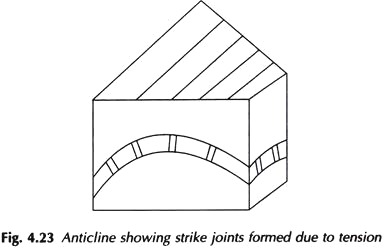ADVERTISEMENTS:
After reading this article you will learn about:- 1. Definition of Joint 2. Classification of Joints 3. Engineering Consideration.
Definition of Joint:
Joints are cracks or fracture present in the rocks along which there has been no displacement. Joints occur in all types of rocks. They may be vertical, inclines or even horizontal. Their dip and strike are measured in the same way as that of sedimentary strata.
Joints are formed as a result of contraction due to cooling or consolidation of rocks. They are also formed when the rocks are subjected to compression or tension during earth movements.
ADVERTISEMENTS:
Commonly, a large number of joints lie parallel to one another. These parallel joints to form a ‘joint- set’. A joint system consists of two or more joint sets.
Classification of Joints:
(A) On the basis of the origin joints may be classified into two groups.
They are:
1. Tension joints:
Tension joints are those, which are formed as a result of tension forces. These joints are relatively open and have rough and irregular surfaces.
ADVERTISEMENTS:
The columnar joints in lava flows and longitudinal joints in the anticline that run parallel to the axis of the fold are the examples of tension joints.
2. Shear joints:
ADVERTISEMENTS:
Shear joints are those, which are due to shearing stresses involved in folding and faulting of rocks.
These joints are rather clear-cut and tightly closed. Shear joints occur in two sets and intersect at a high angle to form a “conjugate joint system”.
(B) On the basis of their altitude and geometry they may be classified as follows:
1. Strike Joints:
Joints that are parallel to the strike of rocks are called ‘Strike Joints’.
2. Dip Joints:
Joints that are parallel to the dip of rocks are called ‘Dip Joints’.
3. Oblique Joints:
Joints, which run in a direction that lies between the strike and dip direction of the rock beds, are called ‘Oblique Joints’.
ADVERTISEMENTS:
4. Bedding Joints:
Joints that are parallel to the bedding planes in a sedimentary rock are called ‘Bedding Joints’.
5. Master Joints:
In sedimentary rocks the joints usually run in two directions at nearly right angles. One set of joints run parallel to the dip direction and the other parallel to strike of these one set of joints commonly more strongly developed than the other and extends for long distances. Such well-developed joints are called ‘Master Joints’.
6. Mural Joints:
Granites show three sets of joints mutually at right angles, which divide the rocks mass into more or less cubical blocks. Such joints are called ‘Mural Joints’.
7. Sheet Joints:
Sheet Joints are often seen in the exposures of granites. These joints run in the horizontal direction and are formed tension cracks during cooling of the rock. These joints are somewhat curve and essentially parallel to topographic surface. They are more conspicuous and closer together near the ground surface.
8. Columnar Joints:
Columnar Joints are formed in tabular igneous masses such as dykes, sills and lava flows. These joints divide the rock into hexagonal columns as shown in Fig. 4.24, which are arranged at right angles to the chief cooling surface. In lavas and sills the columns are vertical, while in dykes they are more or less horizontal.
Engineering Consideration of Joints:
1. In quarry operation joints in rocks are helpful for easier detachment of the rocks.
2. Well-cleaved rocks with many systems of joints are broken at much less expenses.
3. Joints provide passage for the percolation of water and help weathering and formation of soil.
4. Joints control the natural ground water drainage system in rocks and underground.
5. Joints are useful in exploration of water and in location of well sites.


